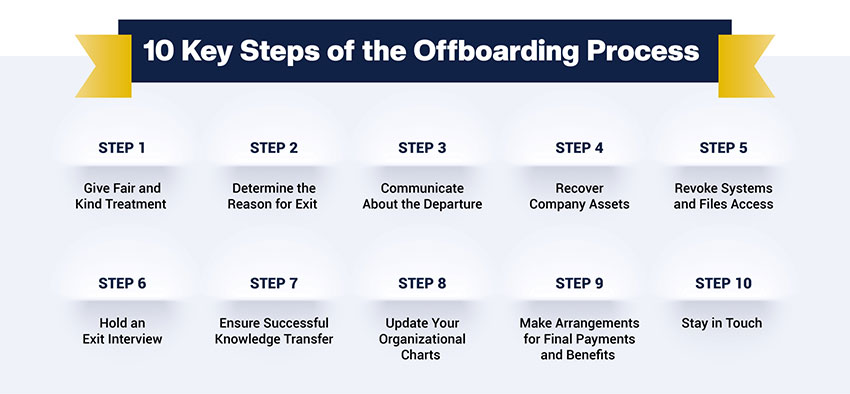A Complete Step-by-Step Guide for Offboarding
April 05, 2024

Offboarding, though one of the important phases of an employee's life, is sometimes overlooked. It marks the farewell of the employee from the organization. The significance of offboarding is more than just waving goodbye to the employee.
Offboarding is a critical legal process that makes sure that departing employees receive entitled benefits and organizations recover assets. It's integral to organizational integrity and requires meticulous execution for a seamless transition.
This comprehensive guide covers everything you need to know about the offboarding process while ensuring a smooth transition for both the employee and the company.
What is Offboarding?
Offboarding signifies an employee's formal exit from an organization, whether due to voluntary resignation or employer-initiated departure. This structured process includes conducting an exit interview and returning company resources.
In some instances, employees may be asked to assist in onboarding their replacements, enhancing overall employee engagement. This professional and authoritative process ensures a smooth transition for both the departing employee and the organization, reflecting thought leadership in HR practices.
Importance of Offboarding
In terms of employee engagement, offboarding is equally important as onboarding.
-
It creates a positive impression of the organization - When an employee transitions from the firm after completing the correct protocol, it demonstrates the commitment and professionalism of the company.
-
Offboarding helps foster long-lasting relationships between the employee and the organization - A well-structured offboarding process helps in building trust and strengthens the bond between the employee and the organization, ensuring a positive closure to their association.
-
It helps the company and employees identify their strengths and weaknesses - During the exit interview, the employer asks several questions. It helps the company and former employees know their strengths and weaknesses and work on them to improve.
-
It is also important from the legal aspect - Initiating an offboarding process ensures the retrieval of confidential company information. This assists in safeguarding against threats and ensuring information security.
Onboarding vs. Offboarding
Offboarding and onboarding are pivotal phases in an employee's journey within an organization. While both are significant, they serve distinct purposes:
Onboarding
Onboarding begins when an employee joins a company. It isn't limited to just giving an offer letter to the concerned employee. It involves making the new employee familiar with the company, its work culture, and other employees. The new employees can clearly understand their roles and responsibilities during this process.
Offboarding
Offboarding signifies the formal departure of an employee from the organization, concluding their active role and responsibilities. Once offboarding begins, employees no longer have any official ties to the company and are treated as separate individuals moving forward.
10 Steps of the Offboarding Process
In the past 12 months, the resignation rate in the US has reached 4%. Therefore, it becomes important to know the proper offboarding process. The key steps involved in the off-boarding process are given below:

-
Step 1: Give Fair and Kind Treatment
The organization should not hold any grudges against employees leaving the organization. Instead, they should acknowledge the employee for their efforts. The company should also congratulate the employees for their progress and wish them the best of luck.
-
Step 2: Determine the Reason for Exit
This is a mandatory step for effective employee engagement. It helps to avoid any communication gap between the employee and the company. The feedback provided by the company will help the concerned employees identify their weaknesses and vice versa. This gives them a chance to work on their shortcomings.
-
Step 3: Communicate About the Departure
The manager should inform the designated authorities and the team head when an employee resigns from their respective position. It helps to avoid any conflicts within the organization. It is also helpful to reassign the duties to someone else or their replacement for an uninterrupted flow of work.
-
Step 4: Recover Company Assets
The company must reclaim all resources from the departing employee before their exit. These assets may include company-issued gadgets, badges, credit cards, uniforms, vehicles, and other items.
-
Step 5: Revoke Systems and Files Access
Revoking access involves removing the former employee's privileges from the company's database. This measure ensures that confidential information remains secure and is not accessible to the departing employee.
-
Step 6: Hold an Exit Interview
The exit interview provides valuable insights into the employee's resignation, helping the organization identify areas for improvement. This process is instrumental in improving the organization's work-life balance and overall effectiveness.
-
Step 7: Ensure Successful Knowledge Transfer
When an employee resigns, it is ideal for them to assist the new employee in familiarizing themselves with the company. If this is not feasible, HR should ensure that the new employee understands the working style of their predecessor, facilitating a smooth transition.
-
Step 8: Update Your Organizational Charts
Updating the organizational charts removes the gaps that can occur when an employee leaves the organization. This prevents any confusion and ensures the smooth functioning of the company’s workflow even after the employee leaves.
-
Step 9: Make Arrangements for Final Payments and Benefits
The company must ensure timely clearance of all pending payments. This includes thorough checks with the finance department to address any outstanding payments or bonuses. This practice mitigates potential conflicts between the employee and the organization regarding financial matters.
-
Step 10: Stay in Touch
An employee's resignation does not sever all ties; it's crucial to end on a positive note. Maintaining occasional and meaningful communication, rather than daily chit-chat, fosters a positive impression of the organization.
Common Mistakes to Avoid During Offboarding
Many companies overlook key aspects of offboarding, which can lead to complications. These common mistakes should be avoided to ensure a seamless transition for departing employees and the organization.
-
Skipping the Exit Interview
Skipping an exit interview can be detrimental to the company as it prevents understanding the true reasons behind an employee's departure. Additionally, it deprives the company of valuable feedback that could inspire future improvements.
-
No Knowledge Transfer Process
The company should learn about the tools, software, or other databases the previous employee used while working. It allows the new employee to take hold of the position quickly and without confusion.
-
Neglecting Paperwork
Neglecting paperwork can pose risks for the company. Completing proper documentation ensures protection against future claims or requests for additional payments or favours from departing employees.
-
Not Using an Offboarding Checklist
The company should prepare a proper checklist before the employee leaves the organization. It will ensure that none of the important things are missing.
-
Not Creating a Remote Offboarding Process
Failing to establish a remote offboarding process can lead to miscommunication between remote employees and the company. It is important for companies offering remote work to implement a structured offboarding process.
-
Lacking Empathy
If an employee wishes to resign, the company should not turn cold with the employee. They should support them and encourage them to do better in life.
Bottom Line
In any organization, employee departures are inevitable, regardless of their success. However, organizations can manage these transitions effectively through a proper offboarding process. This process acknowledges and values the contributions of departing employees, ensuring a positive conclusion to their tenure.
Ignoring the offboarding process can lead to future complications. Therefore, it is crucial to follow each step diligently to maintain a positive relationship between the company and the departing employee. Offboarding is a vital process for both parties, fostering continued goodwill and engagement even after the employee has left the organization.

